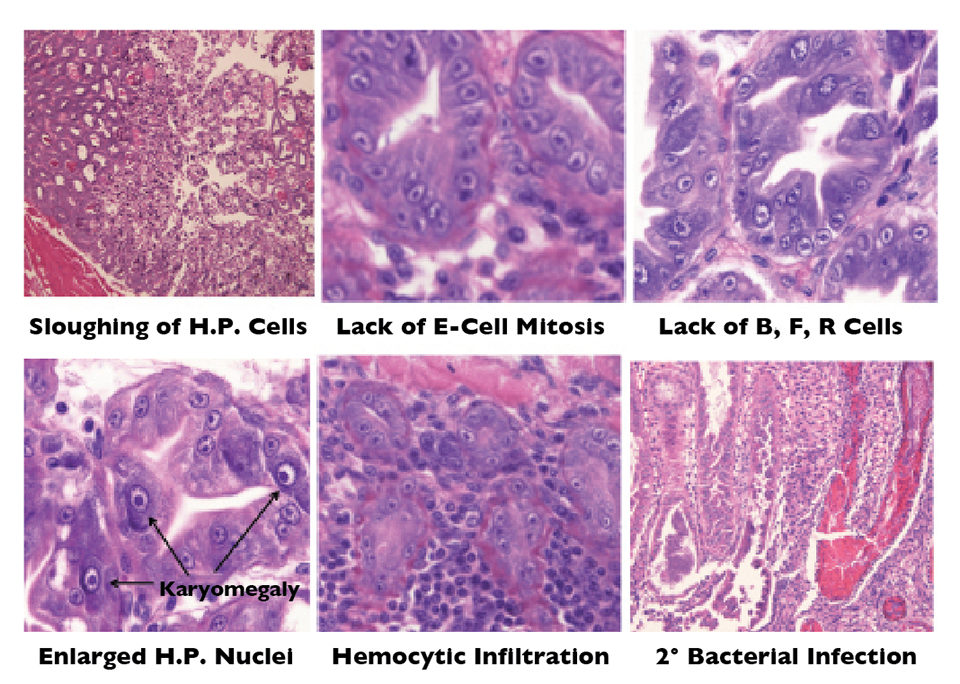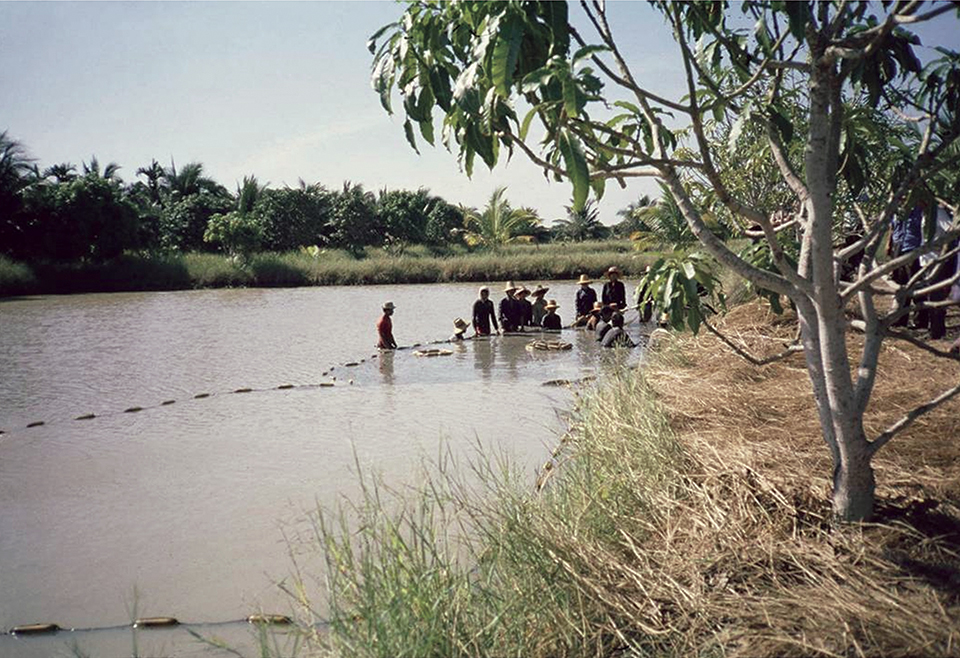Initially ignored, disease causes significant losses

The Asia-Pacific region, the top producer of aquaculture products in the world, is continuously beset by emerging aquatic animal disease problems that can cause high mortalities and economic losses among small farmers as well as commercial producers. Over the last couple of decades, diseases such as white spot syndrome, yellowhead disease and Taura syndrome heavily impacted shrimp aquaculture in the region and caused the collapse of the Penaeus monodon industry.
More recently, an emerging disease known as early mortality syndrome (EMS) – also termed acute hepatopancreatic necrosis syndrome or AHPNS – caused significant losses among shrimp farmers in China, Vietnam and Malaysia. It also reportedly affected shrimp in the eastern Gulf of Thailand this year (Flegel, 2012).
EMS affects both P. monodon and Litopenaeus vannamei and is characterized by mass mortalities during the first 20 to 30 days of culture in grow-out ponds. Clinical signs of the disease include slow growth, corkscrew swimming, loose shells and pale coloration. Affected shrimp consistently show abnormal shrunken, small, swollen or discolored hepatopancreases.
EMS pathology
The primary EMS pathogen has not been identified, but the presence of microbes including vibrios, microsporidians and nematodes has been observed in some samples. Histological work by Dr. Donald Lightner and co-workers showed the effects of EMS appeared to be limited to the hepatopancreas.
The pathology included a lack of mitotic activity in generative E cells; dysfunction of central hepatopancreatic B, F and R cells; and massive sloughing of central tubule epithelial cells. Terminal stages showed massive intertubular hemocytic aggregation followed by secondary bacterial infections.
Similar histopathological results were obtained by Anuparp Prachumwat and co-workers for Thai samples of P. vannamei collected from Chantaburi and Rayong provinces in late 2011 and early 2012 (Fig. 1). The progressive dysfunction of the hepatopancreas (H.P.) results from lesions that reflect degeneration and dysfunction of the tubule epithelial cells that progress from the proximal to distal ends of H.P. tubules. This degenerative pathology strongly suggests a toxic etiology, but anecdotal information suggests that disease spread patterns may be consistent with an infectious agent.
Serious losses
In China, the occurrence of EMS in 2009 was initially ignored by most farmers. But in 2011, outbreaks became more serious, especially at farms with more than five years of culture history and those close to the sea using very saline water. Shrimp farming in Hainan, Guangdong, Fujian and Guangxi suffered almost 80 percent losses during the first half of 2011 (Panakorn, 2012).
In Vietnam, the disease has been observed since 2010, but the most widespread devastation due to EMS has been reported since March 2011 in the Mekong Delta in southern Vietnam. EMS affects the main shrimp production areas of Tien Gang, Ben Tre, Kien Giang, Soc Trang, Bac Lieu and Ca Mau provinces, and a total shrimp pond area of around 98,000 ha.
In June 2011, unprecedented losses were reported for 11,000 ha of P. monodon farms in Bac Lieu. Some 330 million shrimp died in Tra Vinh, and 20,000 ha in Soc Trang suffered huge losses this year (Mooney, 2012).
In Malaysia, EMS was first reported in mid-2010 in the east coast states of Pahang and Johor. The outbreaks of EMS resulted in a drop in L. vannamei production from 70,000 mt in 2010 to 40,000 mt in 2011. Poor production is expected for 2012 with unconfirmed reports of EMS in the states of Sabah and Sarawak.
So far, no potential causative pathogen has been found for EMS. Possible etiologies include biotic or abiotic toxins, bacteria and viruses. Nonetheless, the spread of the disease and its devastating effects on the shrimp industries of the countries affected point to the need for contingency planning in other countries in the region, especially those that practice L. vannamei culture.
Prepare, report
Identifying the primary cause of EMS is important, but until this information is available, increased awareness and preparedness should be implemented by all shrimp-producing countries in the region. Concerned experts, officials and regulatory bodies should formulate ways to prevent the spread and/or occurrence of this disease.
Farmers should cooperate with the concerned agencies by promptly reporting any suspected mortalities among cultured shrimp that display signs of EMS. It is also important that histological examinations be carried out to confirm that suspected occurrences fit the EMS/AHPNS case definition.
Editor’s Note: Cited references are available from the first author.
(Editor’s Note: This article was originally published in the July/August 2012 print edition of the Global Aquaculture Advocate.)
Now that you've reached the end of the article ...
… please consider supporting GSA’s mission to advance responsible seafood practices through education, advocacy and third-party assurances. The Advocate aims to document the evolution of responsible seafood practices and share the expansive knowledge of our vast network of contributors.
By becoming a Global Seafood Alliance member, you’re ensuring that all of the pre-competitive work we do through member benefits, resources and events can continue. Individual membership costs just $50 a year.
Not a GSA member? Join us.
Authors
-
Eduardo M. Leaño
Coordinator
Aquatic Animal Health Program
Network of Aquaculture Centres in Asia-Pacific
P. O. Box 1040
Kasetsart Post Office
Bangkok, Thailand -
C. V. Mohan
Manager
Research and Development
Network of Aquaculture Centres in Asia-Pacific
Tagged With
Related Posts

Health & Welfare
A holistic management approach to EMS
Early Mortality Syndrome has devastated farmed shrimp in Asia and Latin America. With better understanding of the pathogen and the development and improvement of novel strategies, shrimp farmers are now able to better manage the disease.

Health & Welfare
‘Big picture’ connects shrimp disease, inbreeding
Disease problems on shrimp farms may be partly driven by an interaction between management practices that cause inbreeding in small hatcheries and the amplification by inbreeding of susceptibility to disease and environmental stresses.

Aquafeeds
A look at protease enzymes in crustacean nutrition
Food digestion involves digestive enzymes to break down polymeric macromolecules and facilitate nutrient absorption. Enzyme supplementation in aquafeeds is a major alternative to improve feed quality and nutrient digestibility, gut health, compensate digestive enzymes when needed, and may also improve immune responses.

Aquafeeds
A look at phospholipids in aquafeeds
Phospholipids are the major constituents of cell membranes and are vital to the normal function of every cell and organ. The inclusion of phospholipids in aquafeeds ensures increased growth, better survival and stress resistance, and prevention of skeletal deformities of larval and juvenile stages of fish and shellfish species.



